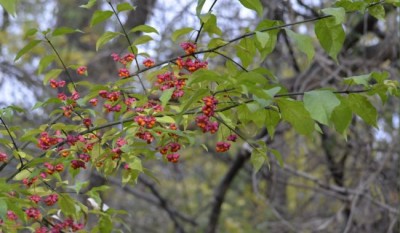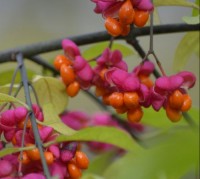When I first saw a shrubby tree in our local “wilderness” with bright pink fruit, I took a closer look. The bright pink part was actually the casing that enclosed an even brighter shiny orange fruit that looked like a berry. The pink petals split apart and pulled back from the orange part to make a vivid colour contrast. I was sure it was some sort of alien invasive as that particular park is full of garden escapees and bird-planted bushes none of which are natural in southern Ontario.

A quick hunt around the internet brought up the name of this pretty alien: Spindle Tree, or Euonymus europaeus. As soon as I saw the name I realized why the fruit looked so familiar. It’s very similar to the smaller, plainer fruit on our decorative backyard Euonymus bushes.
Why is the Tree with the Neat Pink-Petalled Orange Fruit Called a Spindle Tree?
Spindles are those straight, sharp pieces of wood used for spinning fibres into yarn. Many of them are shaped somewhat like spinning tops but with a very long needle at the one end. Remember the old story about Sleeping Beauty? Apparently she didn’t stab herself on a piece of a spinning wheel; she stabbed herself with her (poisoned) spindle.
You can probably see where this one’s going. Euonymus EUROPAEUS. Spindles. Yes, the spindle tree is a European plant that was often used to make spindles. According to a druidery website (!) and Ashridge Nurseries the wood is fine grained, strong and splits easily.
I actually like the name of this invasive.
A Berry by Another Name is an Aril
Have you ever eaten a pomegranate? If so, you may know from the extensive advertising by the POM people, that those red seed-like things you eat out of the middle are called arils.

The orange berry-like part of the spindle tree fruit is also called an aril. It is enclosed inside a pink capsule which splits open as it ripens. The capsule folds back like wings.
Please be aware that the fruits are highly poisonous and several children have become quite ill after eating them, according to the government of Canada biodiversity information group.
Why is this Alien Invasive Spindle Tree So Successful and Spreading Well in Southern Ontario?
This Euonymous is a deciduous tree. It can have multiple trunks. According to the website for Carleton Place Nursery Ltd it is quite tolerant of pollution, various soil types and almost all degrees of soil moisture. That probably explains why it does so well in reclaiming disturbed ground.
According to Toronto’s High Park Nature website (the page has since been retired) both Spindle Tree and Winged Euonymus are spread by birds eating the seeds. The seeds pass through the bird and are dropped and germinate quickly in a new location.
So we have a plant with a seed that birds like to eat and then, er, pass on, dropping it in new locations. The plant then grows under almost any conditions. Sounds like a good recipe for an assertive invasive.
Management of this Invasive Intruder Spindle Tree
Various organizations in southern Ontario are monitoring species like the Spindle Tree and developing programs to manage their spread. You can read one such report by the Credit Valley Conservation Authority at http://www.creditvalleyca.ca/wp-content/uploads/2011/07/091201-RattrayInvasiveMgmntPlan.pdf.
The Other Orange Berry Bush in Southern Ontario is Sea Buckthorn
There is another alien invasive on the prowl in Ontario with orange fruit. It is called Sea Buckthorn. From the photos I’ve seen, though, the fruit is often in a long collection at the end of a branch. I haven’t yet seen a Sea Buckthorn to recognize it, so unfortunately I don’t have any photos. If you search for it on the internet there are lots of images. There are some possible health benefits to the fruit which is leading to increased awareness of the plant. Its fruit is also eaten by birds and the seeds are dispersed hither and yon.
Join In
Have you got Spindle Trees In your neck of the woods? Please share your experiences with a comment.

There are several Spindle trees around Ashbridges Bay in Toronto. I’m recently retired and trying to learn more about local flora and fauna. I’ve noticed the beautiful berries – guess I should call them arils, now – on my walks, but had to Google to identify them. Thanks for furthering my education!
Yes, I keep finding new ones in the GTA too. I guess the birds are very good at spreading the seeds! It’s challenging to id plants and shrubs here with so many introduced species. The Toronto Field Naturalist walks often help me learn some new ones.
Thanks for sharing your sighting!
Interesting read! There are several spindle trees (love the colourful little pods) AND a magnificent massive Sea Buckthorn in Humber Bay park. Gorgeous orange berries and 3 inch thorns. Thanks for the info!
The birds like the berries from both trees which may be how they arrived at Humber Bay. Thanks for sharing your sighting!
I live in southern Michigan and was out walking my dogs in a park behind my house and saw this lovely tree. I thought it was part of the bittersweet family. Had a hard time finding the name. I picked a bunch and placed in vases with water and it looks good. I will see how long it lasts
I am also going to see if i can dry it and use as a fall decoration.
It will be interesting to see if it will dry like Bittersweet!
Found one today in Courtice Ontario. Absolutely beautiful! A shame it’s invasive
There are a few native euonymus but it seems like the showier ones are usually non-native!
Discovered a spindle tree in my fenceline. Never saw one before. Stevensville should I destroy it. Or pull off all the seed pods. It really is nice
It’s really up to you. They are common enough that removing one won’t change the spread of them. I haven’t tried to get rid of the one near me.
my neighbor and ours fence line is 9 to12 feet of this .
Sounds like it has spread! Another possibility is a Euonymus which can have similar fruit.
I live in Lexington NC USA and I found this plant in my woods today.
There are a few types of euonymus that grow in different parts of the country, so I can’t tell you for sure if yours was a Spindle; if not, though, it will be a “cousin” of some type!
I saw these roadside while walking the dog. I had never seen them before and they were different than most things you see growing by the roadside.Being a camera buff I naturally took photos of this strange unfamiliar “fruit”. So that led me to your site while searching out the name of this plant. Is it related to “burning bush” maybe as they seem similar? So good to know about the invasiveness of this plant. First I saw seemingly a lone plant in one location and a second larger plant about 20/30 minutes later. I’m located near Owen Sound on south Georgian Bay.
There are both native and invasive Euonymus trees and shrubs. I’m not sure which one you may have seen. If you have the time, you might want to post your photos on iNaturalist.ca to see what the botanists think is the best id?
I have one in the city part of my backyard in NW Waterloo. It is growing in very rich, well drained soil near a number of buckthorn, pawpaw, mulberry, walnut and poplar trees. I am trying to remove the buckthorn, but that is a job! The berries are amazing!
Yes, I could do without the Buckthorn the birds seed in my yard too!